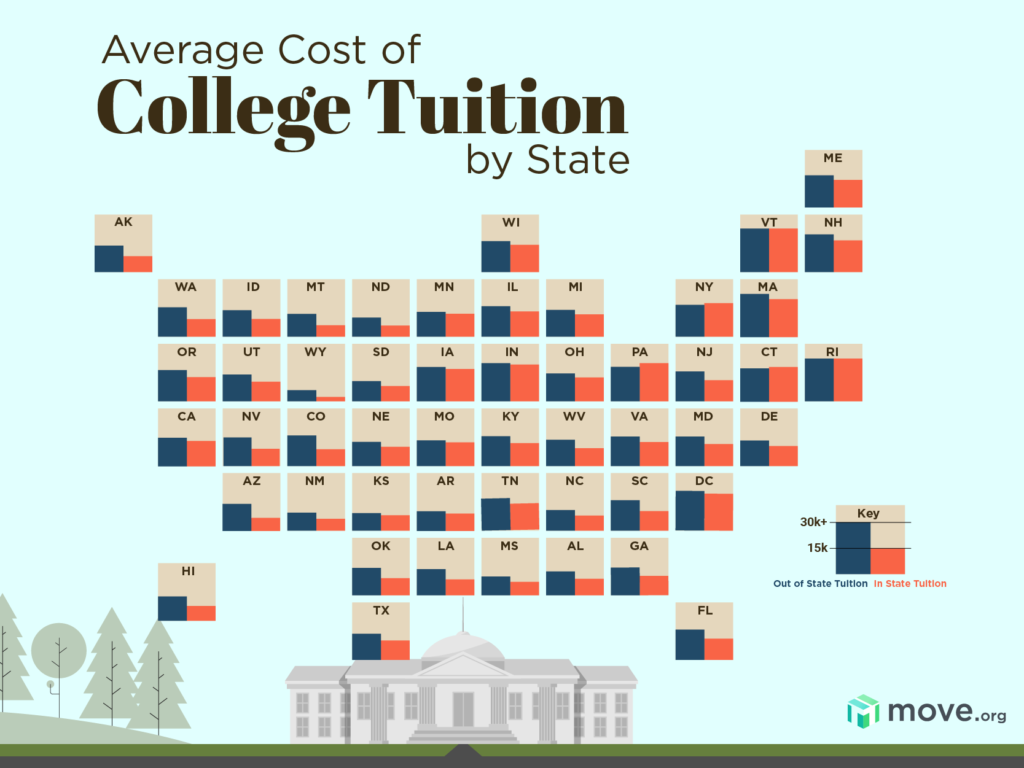 illustration from Move.org
illustration from Move.org
Demystifying Tuition: A Comprehensive Guide to Funding Your Education
The journey to higher education comes with a significant financial consideration: tuition. Understanding the costs and funding options is key for students and families. This guide simplifies tuition payments, offering insights into methods, aid, and expense management.
Why Tuition Costs Are Rising
Tuition has been increasing for years due to:
- Increased operational costs: Higher salaries, infrastructure, tech, and research expenses for universities.
- Decreased state funding: Public schools rely more on tuition due to less state support.
- Demand for quality education: People are willing to pay more for reputable institutions with good facilities and programs.
- Administrative overhead: Growth in administrative staff increases costs.
Understanding these factors can help students and families appreciate the complexities of tuition pricing and motivates them to explore cost-effective options.
Breaking Down Tuition and Fees
Tuition isn't the only expense. Be aware of these fees:
- Tuition: Covers lectures, seminars, and labs.
- Mandatory fees: Supports student activities, health, tech, and library services.
- Program-specific fees: Covers equipment for programs like engineering or art.
- Room and board: On-campus housing and meal plans.
- Books and supplies: Textbooks and software.
- Transportation: Commuting costs.
- Personal expenses: Clothing and entertainment.
Knowing these costs helps with budgeting.
Your Tuition Payment Options
Universities offer various ways to pay:
- Direct payment: Cash, check, or credit card. Requires upfront funds.
- Installment plans: Monthly payments with a small fee.
- Student loans: Borrowing from the government or lenders, repaid with interest.
- 529 plans: Tax-advantaged savings for education.
- Scholarships and grants: Free money based on merit or need.
- Work-study: Part-time jobs for students with financial need.
The best option depends on your situation.
Exploring Financial Aid
Financial aid can reduce tuition costs. Explore these options:
- Federal student aid: Pell Grants and Stafford Loans (FAFSA required).
- State student aid: Aid for residents attending in-state schools.
- Institutional aid: Scholarships and grants from colleges.
- Private scholarships: Scholarships based on merit or other criteria.
Research and apply early. Check resources like Sallie Mae's Scholarship Search, Scholarships.com, and Fastweb.
Smart Ways to Manage Tuition Costs
Beyond aid, try these strategies:
- Consider community college: Transfer to a four-year university after two years.
- Live at home: Reduce room and board costs.
- Dual enrollment: Earn college credit in high school.
- Tuition reimbursement: Some employers offer this.
- Online learning: Often more affordable.
- Used textbooks: Save money.
- Create a budget: Track your spending.
Understanding Student Loans
Student loans are common but understand the terms:
- Federal student loans: Lower rates and flexible options.
- Private student loans: Higher rates and stricter terms.
Before borrowing:
- Loan amount: Only borrow what you need.
- Interest rate: Compare rates.
- Repayment terms: Understand the schedule.
- Repayment options: Income-driven plans.
- Loan forgiveness: Research programs like Public Service Loan Forgiveness (PSLF).
Tax Benefits for Tuition
Several tax benefits can help:
- American Opportunity Tax Credit (AOTC): Up to $2,500 per student for the first four years of college.
- Lifetime Learning Credit (LLC): Up to $2,000 per tax return.
- Student loan interest deduction: Deduct up to $2,500 in interest paid.
- 529 plan tax benefits: State tax deductions and tax-free growth.
Consult a tax professional.
The Impact of Tuition on Enrollment
High costs affect enrollment and completion, especially for low-income and minority students. Affordable tuition promotes educational equity.
Reducing Student Loan Debt
Strategies to manage debt:
- Income-driven repayment plans: Manageable payments.
- Loan consolidation: Simplify repayment.
- Refinancing: Lower interest rates.
- Debt management: Pay off high-interest debt first.
The Future of Tuition
New trends in funding education:
- Income Share Agreements (ISAs): Pay a percentage of future income.
- Online learning: Affordable and flexible.
- Competency-based education: Credit for skills, not seat time.
- Micro-credentials: Recognizing specific skills.
- Subscription-based education: Monthly fee for access to courses.
Financial Literacy
Understanding budgeting, saving, and debt is essential. Universities should offer resources.
Conclusion
With planning and financial literacy, you can achieve your educational goals without excessive debt. Explore funding options, manage expenses, and stay informed.
Ready to take control of your education funding? Explore our comprehensive resources on scholarships, grants, and student loan options. Start planning your future today!
Published on February 19, 2025
reference: Various Article on internet
Gema
Wordsmith and content writer passionate about creating high-quality content that informs, entertains, and inspires. Let me bring your brand's story to life.
All stories by : Gema

0 Comments